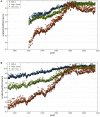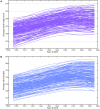Are We Reaching the Limits of Homo sapiens?
- PMID: 29123486
- PMCID: PMC5662890
- DOI: 10.3389/fphys.2017.00812
Are We Reaching the Limits of Homo sapiens?
Abstract
Echoing scientific and industrial progress, the Twentieth century was an unprecedented period of improvement for human capabilities and performances, with a significant increase in lifespan, adult height, and maximal physiological performance. Analyses of historical data show a major slow down occurring in the most recent years. This triggered large and passionate debates in the academic scene within multiple disciplines; as such an observation could be interpreted as our upper biological limits. Such a new phase of human history may be related to structural and functional limits determined by long term evolutionary constraints, and the interaction between complex systems and their environment. In this interdisciplinary approach, we call into question the validity of subsequent forecasts and projections through innovative and related biomarkers such as sport, lifespan, and height indicators. We set a theoretical framework based on biological and environmental relevance rather than using a typical single-variable forecasting approach. As demonstrated within the article, these new views will have major social, economical, and political implications.
Keywords: anthropocene; biometry; environment; human upper limits; life span; longevity; performance; public health.
Figures



Similar articles
-
Age-Related Upper Limits in Physical Performances.J Gerontol A Biol Sci Med Sci. 2019 Apr 23;74(5):591-599. doi: 10.1093/gerona/gly165. J Gerontol A Biol Sci Med Sci. 2019. PMID: 30184188 Review.
-
Historical change and evolutionary theory.Politics Life Sci. 2007 Sep;26(2):46-74. doi: 10.2990/26_2_46. Politics Life Sci. 2007. PMID: 18837585
-
Inconvenient Truths About Human Longevity.J Gerontol A Biol Sci Med Sci. 2019 Nov 13;74(Suppl_1):S7-S12. doi: 10.1093/gerona/glz098. J Gerontol A Biol Sci Med Sci. 2019. PMID: 31001621 Review.
-
[Scientific standards in parasitology in historical perspective].Wiad Parazytol. 2005;51(3):197-207. Wiad Parazytol. 2005. PMID: 16913523 Review. Polish.
-
Has Athletic Performance Reached its Peak?Sports Med. 2015 Sep;45(9):1263-1271. doi: 10.1007/s40279-015-0347-2. Sports Med. 2015. PMID: 26094000 Free PMC article. Review.
Cited by
-
The Performance Gap in Sport Can Help Determine Which Movements Were Most Essential to Human Evolution.Front Physiol. 2019 Nov 19;10:1412. doi: 10.3389/fphys.2019.01412. eCollection 2019. Front Physiol. 2019. PMID: 31803066 Free PMC article.
-
Probing the Promises of Noninvasive Transcranial Electrical Stimulation for Boosting Mental Performance in Sports.Brain Sci. 2023 Feb 8;13(2):282. doi: 10.3390/brainsci13020282. Brain Sci. 2023. PMID: 36831825 Free PMC article.
-
Involvement in Multiple Race Events Among International Para and Non-disabled Swimmers.Front Sports Act Living. 2021 Jan 28;2:608777. doi: 10.3389/fspor.2020.608777. eCollection 2020. Front Sports Act Living. 2021. PMID: 33585812 Free PMC article.
-
Probabilistic forecasting of maximum human lifespan by 2100 using Bayesian population projections.Demogr Res. 2021 Jan-Jun;44:1271-1294. doi: 10.4054/demres.2021.44.52. Epub 2021 Jun 30. Demogr Res. 2021. PMID: 39363909 Free PMC article.
-
Limits to lifespan growth.Front Public Health. 2023 Jan 6;10:1037544. doi: 10.3389/fpubh.2022.1037544. eCollection 2022. Front Public Health. 2023. PMID: 36684960 Free PMC article.
References
-
- Baten J., Blum M. (2012). Growing tall but unequal: new findings and new background evidence on anthropometric welfare in 156 countries, 1810–1989. Econ. Hist. Dev. Reg. 27, S66–S85. 10.1080/20780389.2012.657489 - DOI
Publication types
LinkOut - more resources
Full Text Sources
Other Literature Sources
Research Materials
Miscellaneous

